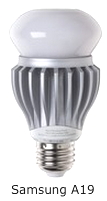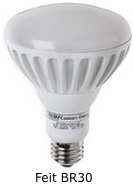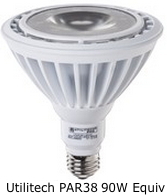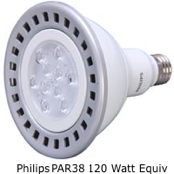|
See Light Bulbs in Home and Garden for comparison of types. About | Color | Terms | Links
About: See LED Global Market Penetration of 50% Expected by 2015 | ledluxor.com, 2013 Why are LEDs better? Edison bulbs function by making a Tungsten filament very hot, and a hot object glows: radiating energy on a broad spectrum of wavelengths, only a small part of which is visible to the eye. The rest of the radiated energy is mostly heat. LEDs function by driving electrons across a junction between two semiconductor materials in which electrons move at different energy levels. When the electrons cross the junction, they drop from the higher energy level to the lower one, and the energy each electron loses when it drops takes the form of light to a large extent. The color of the light is mathematically determined by the energy level difference. So all of the light produced by an LED is the same color, and LEDs can be designed to produce light in the visible range. This precise conversion to one color is why LEDs are referred to as "digital light". There is some waste heat caused by inefficiencies within the LED, however, the net result is a big gain in the percentage of electricity converted to visible light.
A 65 watt (W) Incandescent bulb produces about 800 lumens (lm).
If you had perfect conversion of electricity into light, you would need only 1.0 Watt ("W") of electrical power to produce 700 lumens (lm). Source: LED Light Bulbs Mature At Last - Forbes Dec. 2012 See also Beware - LED bulb reliability | GreenOptions.com In 2013 LEDs were 60 watts or less, but new 1,600 lumen (100-watt incandescent equivalent) are available now, but more expensive
Color:
LEDs come in a cooler white light at 3,000 Kelvin or a warmer, yellow light at 2,700 Kelvin, which is more like an incandescent. One feature of LEDs is that the light can be adjusted to the full spectrum of colors, which opens up some new possibilities. Philips is selling a lighting kit of four bulbs, controllable through a smart phone, where people can choose the color of light from a full palette. The usual measure of an LED lamp's economic life is its L70-the time taken for the brightness to fall to 70% of its original value. |

|
Terms:
Links:
| |





